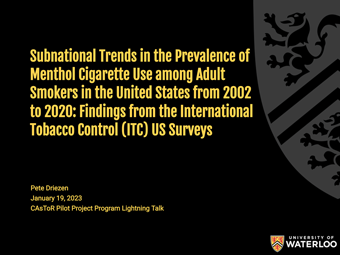“Longitudinal trends in the prevalence of menthol cigarette use and disparities in use at sub-national levels by sex, age, and race/ethnicity: Findings from the International Tobacco Control US Surveys from 2002 to 2020” with Dr. Pete Driezen (University of Waterloo)
- Contact the presenter
- Dr. Pete Driezen <prdriezen@uwaterloo.ca>
- View Abstract +
- Background: Targeted marketing of menthol cigarettes in the United States influences disparities in the prevalence of menthol smoking across demographic groups. Nationally, menthol use has increased since 2004. However, there are no sub-national data documenting differences in menthol use across demographic subgroups. The primary objective of this study was to estimate trends in the prevalence of menthol use among current adult smokers for the nine US census divisions by sex, age group, and race/ethnicity from 2002-2020. Methods: Data from 12 waves of the US ITC Survey (2002-2020) were used to estimate the prevalence of menthol use across census divisions and demographic subgroups using multilevel regression and poststratification (n=12,020), a type of small area estimation model. Weighted multilevel logistic regression was used to predict the prevalence of menthol use in 72 cross-classified groups of smokers defined by sex, age, race/ethnicity, and socioeconomic status. Division-level effects were with a random intercept. Fixed effects were sex (female, male), age group (18-29, 30-49, vs. 50+), race/ethnicity (non-Hispanic white, non-Hispanic black, Hispanic, all others), socioeconomic status (defined as a composite measure of income and education), survey wave, and the division-level labor force participation rate. Interaction effects between sex, age, and race/ethnicity were also fit, along with a random slope for race/ethnicity. In the poststratification step, predicted prevalence was then weighted by the total number of smokers in each cross-classified group, estimated from the Behavioral Risk Factor Surveillance System and American Community Surveys, and aggregated to divisions within demographic subgroup. Estimates were validated against data from the Tobacco Use Supplement of the Current Population Survey (TUS-CPS). Results: The overall modeled prevalence of menthol use was similar to external TUS-CPS estimates (concordance correlation=0.932: precision=0.966, accuracy=0.965), although precision and accuracy declined for sex-specific estimates stratified by race/ethnicity. The prevalence of menthol use increased in each division from 2002-2020. By 2020, prevalence was highest in the Middle Atlantic (46.3%) and South Atlantic (43.1%) and lowest in the Pacific (25.9%) and Mountain (24.2%) divisions. Prevalence was consistently higher among smokers aged 18-29 (vs. 50+) and females (vs. males). Prevalence exceeded 80% among Black smokers in the Middle Atlantic, East North Central, West North Central, and South divisions in all years but only reached 59.0% in the Mountain division in 2020. Prevalence varied most among Hispanic smokers, ranging from 26.5% in the Pacific to 55.3% in New England in 2020. Implications: There was significant variation in the prevalence of menthol use among current smokers across US census divisions from 2002-2020. Prevalence was highest among Black smokers, and varied the most among Hispanic smokers. Results suggest the proposed US FDA menthol ban may exert differential effects across geographic and demographic subgroups, requiring tailored cessation support for smokers following the FDA ban.
- View Bio +
- Pete is a Research Assistant Professor with the International Tobacco Control (ITC) Policy Evaluation Project in the Department of Psychology and holds a cross appointment in the School of Public Health and Health Systems at the University of Waterloo. He is also a co-investigator with the International Cannabis Policy Study. His background is in epidemiology and biostatistics and he earned his PhD in Public Health and Health Systems from UW in 2017 Pete specializes in the statistical analysis of complex survey data, regression modelling, and longitudinal data analysis with an emphasis on generalized estimating equations (GEE). He is also interested in spatial data analysis, small area estimation using survey data, and employing data science methods and tools to support evidence informed health policy. Pete's primary research interests lie in understanding geographic factors influencing population health and how health policy influences human health and behaviour at small area levels. In addition to his work with the ITC Project, Pete has been involved with research on web-based assessment of adolescent nutrient intakes. Dr. Driezen’s profile at University of Waterloo.
 Dr. Pete DriezenUniversity of Waterloo
Dr. Pete DriezenUniversity of Waterloo
